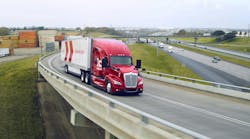Every day thousands of direct-store deliveries (DSD) are made to America's wholesalers and retailers. These deliveries — so vital to our economy and essential to meeting consumers' daily bread-and-milk needs — take longer and cost more with each passing year.
Freight volume handled by trucks will double by 2020 when the U.S. population is 17% larger. During the same period, highway infrastructure growth will be either nominal or all but at a standstill, especially in large urban areas in the Eastern and Central time zones.
Solutions to the resulting gridlock face steep challenges. There are many obstacles to building new roads in time. Allowing bigger trucks — and thus larger payloads through increased size and weight regulations — has no political traction. Instead of improving truck access to many destinations, local governments are cracking down with further restrictions in the name of security.
Nightmare logistic scenarios loom ahead. Cars and trucks increasingly swamp the roadways. Road repair crews will work longer and more frequently within and around cities, putting more constraints on our highway infrastructure.
The clock is no longer a solution. Many drivers already start their day at 1:00 a.m. and many communities are beginning to see 'round-the-clock congestion.
Last year's new hours-of-service rules (HOS) actually cut the clock for many direct-store deliverymen, causing a productivity crisis. According to Lee Falk, a director of logistics for Dean's Food Company, “Drivers typically worry about total hours rather than drive time, although the latter continues getting worse in our larger markets. The HOS rules, which reduced the maximum workday from 15 to 14 hours, hurt productivity for our drivers.
Falk notes that “these drivers can't afford more non-productive windshield time. Our medium-duty truck drivers are putting in a minimum of 11- to 12- hour days and several are working the maximum 14 hours, typically from 3:00 a.m. to 6:00 p.m. Each driver makes 15-20 stops and is paid hourly and/or on commission based on volume. With fewer stops and longer drives to and from stops, you can pretty much see the future unfolding — and it does not look encouraging.”
Driver costs are going through the roof, too. “Not so many years ago,” Falk recalls, “our labor expenses were around 50% of total distribution costs. With health care insurance and worker compensation rates increasing 25% annually, and with wages rising 3%-3.5% per year, the overall labor costs for DSD distribution is now in the range of 60% to 70%. “Higher driver costs,” says Falk, “demand that we optimize transport capacity and driver productivity,”
Falk believes that larger combination vehicles are a partial solution. “We operate in Michigan [which allows larger size and weight trucks] and can realize 17% to 20% greater payload per run. This translates into 150 truckloads per day [to haul] the same cargo volume we need 180 truckloads to haul in Illinois [where the larger trucks are not allowed]. We're simply getting more milk and ice cream delivered with fewer drivers and vehicles.”
Since this subject is of considerable interest to NPTC members, we recently organized a DSD Committee to share ideas on mitigating a future epidemic of “Bessie's longer rides.” For more information, contact me at [email protected].
Gary Petty is President and CEO of the National Private Truck Council. The council's web site is www.nptc.org. His column appears monthly in FLEET OWNER.


